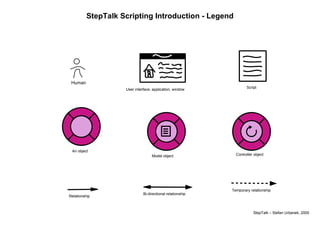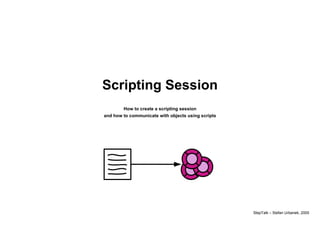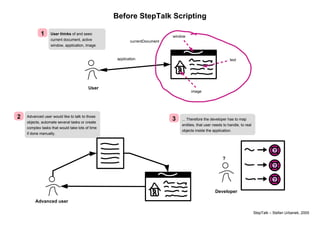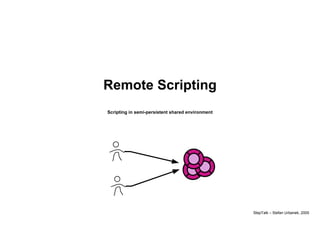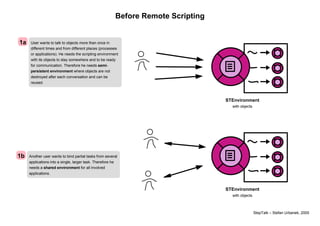StepTalk Introduction
- 1. StepTalk – Stefan Urbanek, 2005 StepTalk Scripting Introduction
- 2. StepTalk – Stefan Urbanek, 2005 Contents Scripting session Remote scripting
- 3. StepTalk – Stefan Urbanek, 2005 StepTalk Scripting Introduction - Legend Human Bi-directional relationship Relationship Temporary relationship Script User interface, application, window An object Model object Controller object
- 4. StepTalk – Stefan Urbanek, 2005 Scripting Session How to create a scripting session and how to communicate with objects using scripts
- 5. StepTalk – Stefan Urbanek, 2005 Before StepTalk Scripting User text window image application currentDocument User thinks of and sees: current document, active window, application, image Advanced user would like to talk to those objects, automate several tasks or create complex tasks that would take lots of time if done manually. ? ? ? ... Therefore the developer has to map entities, that user needs to handle, to real objects inside the application. 1 2 3 ? Advanced user Developer
- 6. StepTalk – Stefan Urbanek, 2005 Before StepTalk Scripting Application Each user-visible entity is somehow represented inside the application. Let us assume that each entity on the screen is a presentation of an object in the application. 4 The developer prepares a mapping between words and objects inside a given context. 5
- 7. StepTalk – Stefan Urbanek, 2005 StepTalk Scripting STEnvironment execution context Objects accessible from scripts object dictionary (NSDictionary) Developer knows objects what are available for scripting. He creates an environment (conversation context). This context will let the computer resolve object names. In other words, computer will know, what is meant by 'document', 'application' or 'selectedObject'. STEnvironment is a context that defines what is behind object names. User can create various environments, one for whole application, one for each document, etc. In the environment objects and classes from frameworks or modules can be included too. Also object finders can be associated for finding unknown objects or distant objects. 6 Developer
- 8. StepTalk – Stefan Urbanek, 2005 StepTalk Scripting STEnvironment execution context Objects accessible from scripts object dictionary (NSDictionary) script (NSString) Script is written in any StepTalk language. The user should specify what language the script is written in. Script can reference objects by their name. Objects are then resolved according to the associated execution context (environment) Developer loads or creates a script – small program in user's preferred programming language. User should know in what language the script is written in. 7
- 9. StepTalk – Stefan Urbanek, 2005 StepTalk Scripting STEnvironment execution context STConversation Objects accessible from scripts object dictionary script (NSString) STConversation is main object for “talking to objects by scripts”. It should be associated with a context (environment). For each execution an engine is created according to a script language. User can have as many conversations as he likes. Ok, now we are ready to 'talk to objects', so the developer creates a conversation object. He makes sure, that the conversation context (environment) is known – that means that the conversation object is connected to appropriate environment object. 8
- 10. StepTalk – Stefan Urbanek, 2005 STEngine StepTalk Scripting STEnvironment execution context STConversation Objects accessible from scripts object dictionary script (NSString) Engine exists temporarily while code execution. It executes the code inside the context (environment). Life of STEngine is undefined and depends on STConversation implementation. That means that for each execution new engine is created or they can be recycled. An engine is created or reused for a given language. There is different engine for Smalltalk language or Ruby language, for example. Engine is set up to operate inside the conversation context (environment). Then the script is executed by the engine. User says: Execute! Each object referenced by a name is resolved through context object dictionary. 9 10
- 11. StepTalk – Stefan Urbanek, 2005 Remote Scripting Scripting in semi-persistent shared environment
- 12. StepTalk – Stefan Urbanek, 2005 Before Remote Scripting User wants to talk to objects more than once in different times and from different places (processes or applications). He needs the scripting environment with its objects to stay somewhere and to be ready for communication. Therefore he needs semi- persistent environment where objects are not destroyed after each conversation and can be reused. 1a STEnvironment with objects Another user wants to bind partial tasks from several applications into a single, larger task. Therefore he needs a shared environment for all involved applications. 1b STEnvironment with objects
- 13. StepTalk – Stefan Urbanek, 2005 Semi-persistent Scripting Environment Process Remote Scripting STEnvironment execution context STEnvironment Process Semi-persistent Scripting Environment process is created. The environment will be referenced by its name. The process contains single scripting environment object that would serve as execution context for future scripts. 2 STEnvrionmentProcess is created by launching the stenvironment tool. Currently a Distributed Objects server object is registered that represents the process. To the server conversation connections are going to be created.
- 14. StepTalk – Stefan Urbanek, 2005 Semi-persistent Scripting Environment ProcessApplication 1 Remote Scripting STEnvironment execution context Application 1 Conversation STConversation STEnvironment Process STDistant- Conversation User creates a distant conversation object and specifies a name of the distant environment in which conversation is going to happen. 3 The distant conversation object connects to the named scripting environment process and creates a connection. A new conversation object is created in the environment process. 4
- 15. StepTalk – Stefan Urbanek, 2005 Semi-persistent Scripting Environment ProcessApplication 1 Remote Scripting STEnvironment execution context Application 1 Conversation STConversation STContext conversation context STEnvironment Process STDistant- Conversation Conversation context is created. The environment (execution context) is set to be the parent of the conversation context. 5 Proxy of the freshly created conversation object is vended through the Distributed Objects connection back to the distant conversation on the application side. 6 Note: The mentioned creation and use of conversation context object is not yet implemented. The conversation connects directly to the environment object therefore user can not have conversation specific objects, everything is shared.
- 16. StepTalk – Stefan Urbanek, 2005 Semi-persistent Scripting Environment Process Application 2 Application 1 Remote Scripting STEnvironment execution context Application 1 Conversation STConversation STContext conversation context STEnvironment Process Application 2 Conversation STConversation STContext conversation context STDistant- Conversation STDistant- Conversation Another application can connect to the same environment and share it. Or the first application can close the conversation and reopen it later. 7



